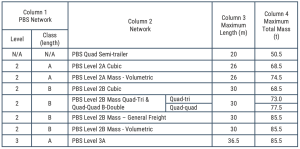The National Heavy Vehicle Regulator (NHVR) has released a new authorisation notice: ‘National Class 2 Performance Based Standards (High Productivity) Authorisation Notice 2021 (No. 1)’.
Smedley’s Engineers’s specialist PBS consultant Chris Nisbet says, “The key takeaway from this notice is that the system is being simplified for operators, who will no longer have to wait for permits on the whole. While there is still the need to get last mile access, many operators that operate between key locations will be able to use the combinations sooner and with less paperwork. With the published maps now also showing where issue bridges are, decisions can be made on direction before applications are made based on mass or the shortest distance between points.”
Smedley’s Engineers has summarised the authorisation notice below and has also published detailed information sourced directly from the authorisation notice, which can be found here.
SUMMARY
What has changed:
- No longer a HPFV network; now logical networks for Cubic, General Freight and Volumetric freight for 30 and 36.5m combinations
- Quad, Quad Tri and Quad Quad B-Doubles now also allowed network access up to full mass
- Self managed routing using open maps rather than permits
- Unlike the tier 1 notice released late last year the new notice is for Tier 3 up to full mass operation.
What hasn’t changed:
- Last mile access still requires permits
- Bridge limits still apply with many more issue structures for General Freight than Volumetric
IN DETAIL
This Notice authorises access to specified networks by eligible Performance Based Standards (PBS) vehicles that hold a PBS vehicle approval. They must also comply with the other conditions of this Notice and its Schedules. Authorised access to the areas and routes specified in this Notice is limited by conditions including PBS tier ratings or template vehicle requirements.
A vehicle will need to comply with both its own PBS vehicle approval and the conditions of this Notice to access a given area or route.
Template vehicle means a generic vehicle specified by a set of parameters including mass, dimensions and axle spacing. A template vehicle may be described by way of a drawing.
Template vehicles are used in this Notice to match specific vehicle configurations with access to specific routes or areas. A network, either in network provision of this Notice or as a condition on the network itself, may specify compliance with a given template vehicle or vehicles.
1. Application
- This Notice applies to a PBS vehicle with a PBS vehicle approval issued under section 23 of Part 1.4 of the HVNL.
- This Notice applies to a PBS vehicle in participating jurisdictions subject to the conditions provided in the Schedule of this Notice relevant to that jurisdiction.
2. Conditions: Stated Areas and Routes (Networks)
- Pursuant to the authorisation granted in sections 8 of this Notice an eligible vehicle may operate on a network named in Column 2 of Table 1, on condition that it has a PBS Approval that meets the requirements for the PBS network listed in Column 1 and does not exceed the maximum length and mass requirements in column 3 and 4.
Table 1: Victorian networks

Note: The networks named in Column 2 of Table 1 are published and maintained by the Victorian Department of Transport and are available on its website.
PBS Quad semi-trailers are PBS Level 1 vehicles with regard to safety and geometry, but access is determined by the mass of the combination and not by network level or class.
The PBS 2A and 2B Cubic networks are ones designed to accommodate longer vehicles that, because of the low-mass and high-volume nature of their loads do not reach a total mass of more than 68.5t.
- In addition to complying with the requirements in Table 1, an eligible vehicle operating on a network under this section must comply with the dimension limitations and other requirements of a template vehicle specified as a condition of that network.
Note: More than one template vehicle may be provided for a single network, in which case compliance with only one template is required.
- The networks named in Column 2 of Table 1 are routes and areas under this authorisation Notice for the purposes of sections 8 and 10.
- In this section total mass means the mass of the eligible vehicle including its load.
3. Conditions – vehicle conditions
- An eligible vehicle must have:
1. an antilock braking system (ABS) that complies with ADR38/01 on all axles, excluding those on convertor dollies;
2. and certified road friendly suspension.
- An eligible vehicle that contains a prime-mover manufactured after 2007 must the meet the ADR80/02 emissions control standard.
4. Conditions – Intelligent Access Program (IAP) or Telematics Monitoring Application (TMA) & on board Mass (OBM) (Victoria)
- Pursuant to section 12 of this Notice, an eligible vehicle operating on a network under this Schedule that is a:
- vehicle with total mass greater than 68.5t; or
- a quad semi-trailer exceeding 46t gross combination mass
must be enrolled in and comply with one or both of the following approved intelligent transport systems, approved by Transport Certification Australia (TCA):
On Board Mass Management Category B (OBM B); or
On Board Mass Management Category C (OBM C)
- Pursuant to section 12 of this Notice, an eligible vehicle operating on a network under this Schedule must be enrolled in and comply with one or both of the following approved intelligent transport systems, approved by Transport Certification Australia (TCA):
Intelligent Access Program (IAP), or
Telematics Monitoring Application (TMA)
- Any approved intelligent transport system required under this section must be functioning while operating under this Notice.
5. Condition – Crossing railways and tramways
If an eligible vehicle is longer than 26m, before attempting to cross a railway or tramway track the driver or operator of the vehicle must first obtain permission from the Transport Compliance Unit of the Department of Transport’s Over Dimensional Load Team.
Chris Nisbet comments, “Our understanding is that this can be an annual call to the rail authority and is not required on a daily or crossing basis.”

